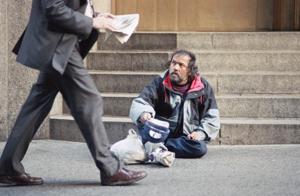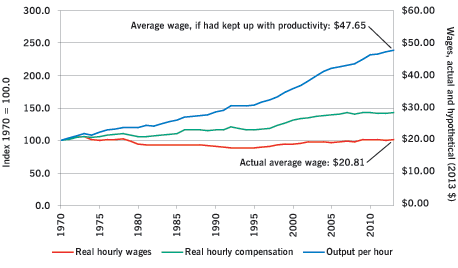The Profile of Inequality of Income and Wealth
I read an article by Lawrence Mishel at the American Prospect and left this comment. My comment:
Income Shares --- Are they Healthy? "The lower-earning 45% of U.S. households all with incomes below $40,000 a year, earns in market income about 11.5% of all income, while the top-earning 20%, all with incomes above $100,000, earn 60.0% of all income. This comes out of the Congressional Joint Commission on Taxation (see here, page 30). When I convert this to average income per household, it means that the lower 45% have one dollar of income while the higher 20% have $11. This 1 to 11 ratio between nearly half and the better earning 20% is an unhealthy balance. Living standards for half are strained. And then I looked at the CBO report on income distribution for 2011 (see page 2) and see the same ratio. The market income disparity is relieved by government transfers and taxation, but the final disparity is glaring, 1 to 6 instead of 1 to 11.
International Comparisons We are becoming like Mexico, which has the greatest inequality between the 20th and 80th quintiles, and our social ambience will become like Mexico’s as we continue down this line. The OECD places the U.S. income inequality at 4th worse out of 34 advanced nations (see page 45, "inter quintile share ratio 80/20). Mexico's 20th to 80th quintile average income ratio is 13.0 while the U.S. has 7.7. Lawrence Mishel says (at article cited above) that for 70% of the workers wages have been flat for almost 40 years, while the economy’s growth per human has more than doubled since 1964, by a factor of 2.6 times, a percentage of 160%. It's a stunning loss of income for the vast majority of Americans. "Raising America's Pay" is the call of the EPI, which also presents a wage calculator where one can discover what one's income would be if wages and productivity had matched. Not to be missed is the article "Wage Stagnation in Nine Charts" from the EPI.
Wealth Disparity Wealth disparity is far worse. Professor Saez released a report showing that one in 1,000 has as much savings as 900 in a 1,000, both have about 23% of all wealth. (And read more here) Bernie Sanders seems to be the only politician speaking out about cures." More to come. But of course you could read the 2014 posts on inequality and capture most of what I have to say.


Weekly Wages Today Are Lower than
1964 Wages for 80% of Workers Even Though the Economy Is Two and a Half Times More Productive Per Worker
Dollars and Sense magazine published this graph, but the article is not on the web. (They also published 11 graphs at the end of 2014 well worth our time to contemplate, here.) Total compensation rose by 40% because insurance companies charged employers more for medical insurance. Employees never experienced a raise. Average hourly wages have gone up by 8% since 1964 while average weekly wages have declined by 4%, see the graphs below from the Federal Reserve. Wage income as a share of national income has declined from 51% to 42%, an amount equal to today's $1.26 trillion; and if the former 51% share went to wages then 80% of households would have $10,000 plus income, and poverty would not exist (because I'm distributing the $1.26 trillion equally to all households in the lower-earning 80%).
The Federal Reserve graphs show that average weekly wage earnings for nonsupervisory employees since 1964 have decreased by 4%. Here are a few Fed graphs showing how poorly the economy has served employees --- here, here, here, and here. Use the BLS inflation calculator, here, and you can learn that incomes have stayed flat. Lawrence Mishel says, in the article cited above, that for 70% of workers, all employees, wages have not budged since 1970.
The EPI details lopsided income growth since 1979, the net result is "Change in Income" for top 1% = 180.9%, for the bottom 99% = 2.6%, Top 1% share of all income growth, 88.5% over 33 years. At Measuring Worth we see in those 33 years GDP per capita increased by 70.3%, from $28,725 to $48,908. Again, 88.5% of that growth went to the top 1%. The difference between the 1% and the average 99% is 30 times.
One in Four Workers Are Out-of-Luck
_____________________________________One in four U.S. adults who would like to work are either not working, working only part-time and want full-time, or are working for poverty wages full-time and year-round. One in four is 25% or about 40 million adults. Now I'll try to prove it:
Look at National Jobs for All Coalition's monthly employment report, njfac.org. They state that 21.9 million are 1) not at work or 2) not working full-time but want full-time. Then they state that 18.5 million workers are 3) working full-time, year-round at less than poverty wages which they put at less than $23,850. This comes out to less than $11.50 an hour. A total of 40.4 million out of a workforce of 156 million (see here) is more than 1 out of 4.
I could argue that this number is greater, but I won't. Who would read it? It was larger a year ago, about 28% of the labor force.
So, things are improving.
I read the December 2014 report of the Council of Economic Advisers, and I am upbeat, at last. Things are improving. But, one in four either working poor or not working? And 45% earning just 11.5% of all income while the top 20% earn 60.0%? A ratio of 1 to 11. And the top 1 in a 1,000 owning more than the lower 900 in 1,000? We have quite a long, long road before we reach upbeat.
The System Is Not Working _______________________________________When I think 1 in 4 workers are either not working, not working enough, or being paid a sub-poverty wage, I think this system is not working. Today I saw an old campaign poster for the local Tea Party winner, and it said "Freedom Works". For whom?
The nation needs to get voters to vote. And to get money out of political campaigns. And to create public employment to drive up wages, while reforming laws pertaining to labor unions. I've gone over this in previous reports.
In a more real way, we are witnessing a collective movement of hearts. A very slow awakening of the importance of the economy, a shift of the old story of freedom to one of cooperation. Caring will at last form the basis of voting. Since there is so much wealth and income --- it is absurd to think that for long we can hold the natural instincts down with fear, paranoia, class animosity, and demagoguery. We are reasonable and understanding. "We'll come to understand that we like each other more than we thought we did," was my answer to "How will it ever change?" We'll come to care more and apply our strengths to making equal opportunity and more-or-less equal outcomes happen. I can't say it clear enough. Too many of my friends insensitively and arrogantly predict calamity. I disagree, but the future will be difficult, both good and bad will come forth. The good will be much more powerful. But that matters little, each person will have to demonstrate his convictions and act.
Here's a nice read about inequality in movement, from Too Much, again. Two British epidemiologists discuss the powerful insights about inequality, disease and health outcomes, and the reaction to their story, "Pickett: Actually, I don’t think people find what we’re talking about all that difficult at all. I think they find that what we’re saying, about the impact of inequality, is intuitively making sense of their own experiences. So the most common reaction we see among audiences when we’re talking is nodding."
________________________________________
Maryland Congressman with a Bold Plan A news report Congressman Chris Van Hollen's plan for a $2,000 tax credit for middle class couple's taxes (an income increase of $1.2 trillion over ten years to about 50% of households), a Financial Transaction Tax, and for a fine on corporations that boost only CEO pay while employee pay falls. See KPFA's Pacifica Evening News, January 14, 2015. The video of Van Hollen at the CAP is here, 58 minutes. I watched the entire 58 minutes, I feel I should watch it again.
The nation's surplus is going to waste.
$25 trillion of new savings has been created in the past 6 years, since 2008 (see Federal Reserve report, page 2). An increase of $78,000 per human, or a 30% increase per capita. It's a stunning increase. Haven't you noticed how much better things are, how much new construction is happening, how strained we are to meet the influx of all the new demand?
No? Why not? Because all that surplus is going to waste, that's why. Van Hollen's plan, and others like it would put the surplus to productive use. Since 2008 the economic output, GDP, has been $90 trillion, and savings has increased by $25 trillion, and that's an amazing amount of savings. Too bad it goes to absolute waste.
The CPEG program purports to raise close to $1,000 billion a year while Van Hollen's plan only $120 billion. CPEG recommends: "c) As we exploit our (greatest remaining economic “asset” - rentierism) we need to shrink it and eventually eliminate it. A straightforward way to do both (exploit and gradually eliminate) is to impose a financial transaction tax on all financial trading in the U.S. and with European collaboration (the EU parliament has already recommended this) worldwide.11 It is indicative of the degree of economic distortion of our rentier economy, that this one tax has the potential to raise up to $ 1 T a year and fund up to 25 M living wage jobs over 5 years (Barclay, 2005) (CPEG, 2009,2011). This should be immensely politically popular, would directly repress rentier activity, and if used for a jobs program, directly redevelop the productive side of our economy."
The Van Hollen video is a convincing public display by a knowledgable Congress Representative, and it should have a durable impact as he seeks to publicize it. Watch it.
Also, here's a short piece from the Brookings Institute on the CBO report that has caught my attention. To quote: "Between 1979 and 2011, CBO calculates, inflation-adjusted market income for the bottom 20 percent of households rose by 16 percent. For the middle three quintiles of households (the 21st to the 80thpercentile, this income also rose by 16 percent. For households between the 81st and 99thpercentile, it rose by 56 percent. And for the top 1 percent of households, it rose by 174 percent."
See the web page Measuring Worth and calculate as I did that the per capita growth of the nation increased by 70.2% between 1979 and 2011. Not 16%, 70%. Michel's article covers this too.
The CBO report mentioned in the Brookings report will be the topic of a soon to be posted essay here.
No comments:
Post a Comment